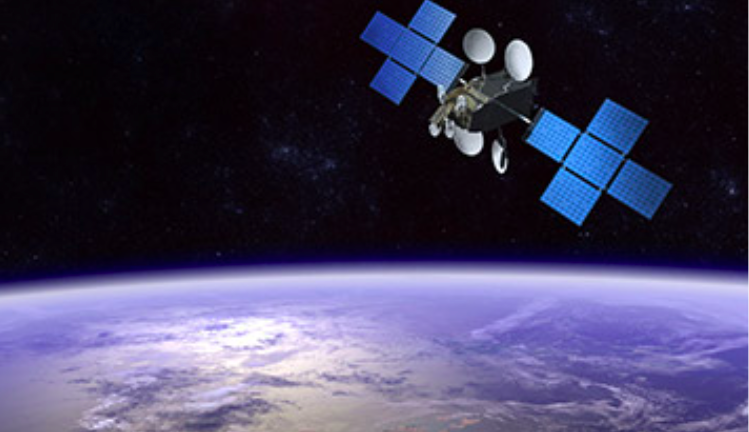
Viasat 1 (Viasat)
WASHINGTON: In a surprise move, California-based Viasat this morning announced a plan to acquire UK-based Inmarsat for a cost of some $7.3 billion — potentially creating a commercial satellite communications behemoth worth $4.1 billion in 2021 revenue, of which 40% is in government sales, including to the Defense Department.
While the acquisition will require approval from regulators, the combined company already is planning an expansion of its on-orbit assets, including two polar orbiting satellites that can bring capacity to the Arctic. As global warming opens the potential for economic activity in the far North, including oil and gas extraction, world powers are jockeying for position there and military tensions are on the rise.
RELATED: NORTHCOM needs help in space for Arctic communications
Both companies orbit satellites in Geostationary Orbit, some 36,000 kilometers in altitude, but concentrated on slightly different market sectors.
“We’ve seen GEO operators investing in or acquiring satellite companies to expand their service portfolios and distribute traffic in more efficient ways,” one industry source familiar with both firms told Breaking Defense. “I suspect this will be part of a broader strategy to provide comprehensive service offerings.”
Susan Miller, CEO of Inmarsat Government, told Breaking Defense in an email that together “Inmarsat and Viasat will utilize their highly complementary capabilities and geographies to deliver superior, cost-effective solutions for Inmarsat’s global mobility customers well into the future.” Based in Reston, Va., Inmarsat Government is the British company’s US arm responsible for sales to government agencies.
 Inmarsat currently is a major provider of mobile communications for the US military, via Space Force’s Commercial Satellite Communications Office (CSCO), which just announced plans to acquire some $2.3 billion in commercial bandwidth, equipment and services in 2022 and 2023. In addition, the Navy in 2016 signed a separate contract for maritime communications services with Inmarsat that runs through the end of this year.
Inmarsat currently is a major provider of mobile communications for the US military, via Space Force’s Commercial Satellite Communications Office (CSCO), which just announced plans to acquire some $2.3 billion in commercial bandwidth, equipment and services in 2022 and 2023. In addition, the Navy in 2016 signed a separate contract for maritime communications services with Inmarsat that runs through the end of this year.
Commercial firms provide the bulk of military communications in both peacetime and wartime. In the first-ever Breaking Defense Space Survey, 53.7% of DoD respondents said commercial SATCOM was “extremely important” during war; another 37.2% said it was “very important.”
RELATED: Cyber concerns, classification woes lead Space Survey results
“There are no changes to our customers services at this time,” Miller explained. “We have communicated the news to our customers and partners and will keep them informed as to any planned changes as we approach the transaction close.”
That closure is expected to take place in 2022, according to slides presented by corporate officials from both companies to their investors this morning.
Viasat’s four operational satellites provide internet access for commercial and government clients. In addition, much of its work with DoD has primarily focused on hardware, such as ground stations and handheld radios, as well as software to improve cybersecurity and enable 5G mobile communications. For example, the company in September won two awards for an unspecified amount from DoD’s Information Warfare Research Project (IWRP) “to conduct research that will examine the use and implementation of 5G networks on the battlespace,” according to a company press release.
“While Viasat was well positioned before before, now we’re even stronger in the fast-growing space-centric global mobility and government markets,” Mark Dankberg, Viasat executive chairman told the investor meeting.
The industry source painted a slightly less rosy picture for Viasat, however, saying it struggles to remain relevant in the market for internet services from space. Because of the distances involved, its GEO-based internet service is much slower than that provided by operators such as SpaceX using lower orbits that can provide high-speed, high-capacity bandwidth with less lag time in data delivery.
“Viasat has been undergoing an existential crisis as it competes with SpaceX for the satcom market,” the source said.
Indeed, the company sued the Federal Communications Commission (FCC) in May to overturn the decision to approve launches by SpaceX to fill out its Starlink constellation, according to a detailed report in Ars Technica, arguing that the FCC didn’t properly take into account the environmental impacts such as debris and light pollution required by the National Environmental Policy Act (NEPA). The US Court of Appeals for the District of Columbia Circuit is scheduled to hear oral arguments on Dec. 3, but the court has already raised a skeptical eyebrow. In July it dismissed Viasat’s petition to block Starlink launches until the lawsuit was resolved.
And while “Viasat has long been a supplier of secure comms to gov/military (including Air Force 1),” the source noted, the company “realizes that they need global coverage to be able to compete.” That is something that Inmarsat, with its constellation of 14 birds, can provide.
From Viasat’s perspective, Dankberg said, they believe the new combined firm can grow substantially as the international commercial SATCOM market expands “because so much of this market is either underserved or totally unserved now.” He explained that collectively, “our total addressable market already very large, at close to a trillion dollars and it’s expected to grow to nearly 1.6 trillion by 2030.”
The total international government market, worth some $81 billion this year and largely representing DoD buys, is expected to grow to $130 billion by 2030, he added.

Viasat’s projected market growth after Inmarsat acquisition.
“The combined company intends to integrate the spectrum, satellite and terrestrial assets of both companies into a global high-capacity hybrid space and terrestrial network, capable of delivering superior services in fast-growing commercial and government sectors,” explained today’s joint press release. The combined company will bring several key offerings to customers, the release added, including:
- A broad portfolio of spectrum licenses across the Ka-, L- and S-bands and a fleet of 19 satellites in service with an additional 10 spacecraft under construction and planned for launch within the next three years.
- A global Ka-band footprint, including planned polar coverage, to support bandwidth-intensive applications, augmented by L-band assets that support all-weather resilience and highly reliable, narrowband and IoT connectivity.
- The ability to unlock greater value from Inmarsat’s L-band spectrum and existing space assets by incorporating Viasat’s state-of-the-art beamforming, end-user terminal and payload technologies and its hybrid multi-orbit space-terrestrial networking capabilities.






















